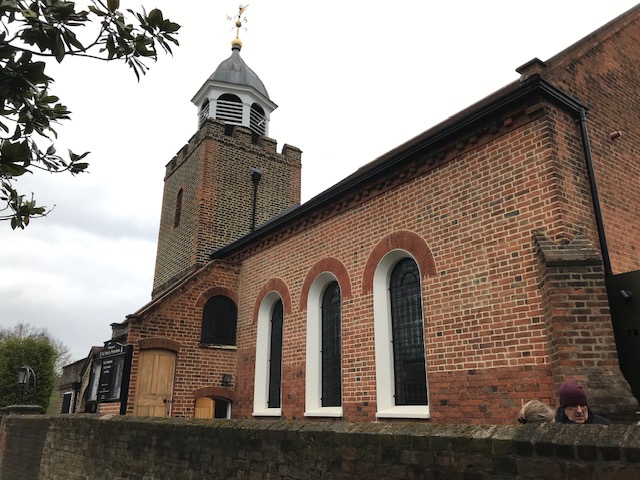St. Peter’s church at Petersham, just outside Richmond, overlooking the Thames, has a fascinating history to which today’s building fails to do justice. Pevsner thinks it “charming” but I have to disagree. The district of Petersham contains mansions built for the gentry and aristocrats of the eighteenth century, and at first sight we might be forgiven for supposing that the church itself was of a similar age, a prim red-brick structure of neo-classical appearance. But its bizarre shape hints at something more complex, for this church is wider than it is long, its nave and chancel dwarfed by its transepts.
But even if the building does not appear to be ancient, the site is: today’s church is the third to stand here. The first was Anglo-Saxon, and is recorded in the Domesday Book where the place-name is given as Patricesham. As usual with Saxon churches, we have no idea when or by whom it was built. We do know however that in the seventh century this area was granted by Frithuwold, a ‘sub-king’ of the Mercian king Wulfhere, to Chertsey Abbey. The charter which sets this out is famous for being the first known document to refer to ‘Surrey’ – although the precise location, extent and status of this seventh century ‘Surrey’ are all unclear.
No trace of the Saxon church survives; it was replaced after the Conquest by a second building, put up in the twelfth and/or thirteenth century. The sole remaining visible relic of this medieval phase is a blocked-up lancet window on the north side of the chancel.
The window dates to the late thirteenth century, which gives us a terminus ante quem, a latest possible date, for construction of the church as a whole.
By this time Petersham church had become a token, a playing-piece in ecclesiastical power-games. Since the seventh century the manor – and presumably the church – had belonged to Chertsey Abbey, a connection which was confirmed in the Domesday Book in the eleventh century. But some time after this the church was re-designated as a chapel belonging to the important church at Kingston. And then in the thirteenth century Kingston itself, together with the Petersham chapel, was acquired by the increasingly powerful and acquisitive Priory at Merton.
This arrangement continued for three hundred years and was still in place in 1505 when the medieval church was largely demolished and replaced by the third church. It is unclear what prompted this: the early sixteenth century was not a particularly busy time for parish church renovation. But as things turned out, Petersham’s new church was probably one of the last built in Catholic England; less than forty years later Merton Priory was swept away by the Reformation, and the former chapel embarked on a new career as an Anglican parish church.
The church built in 1505 forms the core of the building which stands today. But it has been continually added to, and eventually overwhelmed, by numerous extensions in the seventeenth century (new south transept and west tower), eighteenth century (new north transept) and nineteenth century (south transept enlarged, north transept heightened). Hence the building we see today, which contrives somehow to be both prim and eccentric.
SOURCES
Bridget Cherry & Nikolaus Pevsner, The Buildings of England: London 2: South, Penguin Books, London, 1994, p. 514.
John Cloake, Richmond Past, Historical Publications, London, 1991.
A History of the County of Surrey: Volume 3. Victoria County History, London, 1911.


